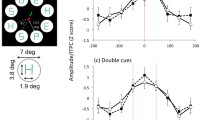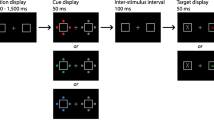Abstract
Event-related potentials (ERPs) were recorded in subjects while they were matching two sequentially presented color spots. The two spots might be presented in the same position of the same color, or different colors (color conflict). They might be in different positions of the same color (position conflict), or different colors (color and position conjunction conflicts). Subjects matched the stimuli in three different sessions according to different attention tasks: attending to color, attending to position, or attending to both color and position. A negative one-peak brain potential, N270, was elicited in all the conflict conditions with amplitude enhanced in the task-relevant conflict. Two negative effects, N270 and N400, were recorded when attending to the conjunction conflicts concurrently. Visual spatial information is processed through the dorsal stream, while the feature information is processed through the ventral stream in the brain. The results suggest that all kinds of conflicts might be processed in a common system above the level of the two streams, which processes the conjunction conflict information from ventral and dorsal stream in series.




Similar content being viewed by others
References
Botvinick M, Nystrom LE, Fissell K, Carter CS, Cohen JD (1999) Conflict monitoring versus selection-for-action in anterior cingulate cortex. Nature 402:179–181
Carter CS, Braver TS, Barch DM, Botvinick MM, Noll D, Cohen JD (1998) Anterior cingulate cortex, error detection, and the online monitoring of performance. Science 280:747–749
Carter CS, Macdonald AM, Botvinick M, Ross LL, Stenger VA, Noll D, Cohen JD (2000) Parsing executive processes: strategic vs evaluative functions of the anterior cingulate cortex. Proc Natl Acad Sci USA 97:1944–1948
Corbetta M, Shulman GL, Miezin FM, Petersen SE (1995) Superior patrietal cortex activation during spatial attention shifts and visual feature conjunction. Science 270:802–805
Cui LL, Wang YP, Wang HJ, Tian SJ, Kong J (2000a) Human brain sub-systems for discrimination of visual shapes. Neuroreport 11:2415–2418
Cui LL, Wang YP, Wang HJ, Tian SJ, Wang DQ (2000b) The effects of probabilities on event-related potential N270. J Brain Nerv Dis (Shijiazhuang, China) 8:275–278
Felleman DJ, Van Essen DC (1991) Distributed hierarchical processing in the primate cerebral cortex. Cereb Cortex 1:1–47
Kanwisher N, Driver J, Machado L (1995) Spatial repetition blindness is modulated by selective attention to color or shape. Cognit Psychol 29:303–337
Kong J, Wang YP, Zhang W, Wang HJ, Wei H, Shang H, Yang X, Zhuang D (2000) Event-related brain potentials elicited by a number discrimination task. Neuroreport 11:1195–1197
Liu Y, Gao JH, Liotti M, Pu Y, Fox PT (1999) Temporal dissociation of parallel processing in the human subcortical outputs. Nature 400:364–367
Luck SJ, Hillyard SA (1994) Electrophysiological correlates of feature analysis during visual search. Psychophysiology 31:291–308
Menon V, Mackenzie K, Rivera SM, Reis AL (2002) Prefrontal cortex involvement in processing incorrect arithmetic equations: evidence from event-related fMRI. Hum Brain Mapp 16:119–130
Rao H, Zhou T, Zhuo Y, Fan S, Chen L (2003) Spatiotemporal activation of the two visual pathways in form discrimination and spatial location: a brain mapping study. Hum Brain Mapp 18:79–89
Tian SJ, Wang YP, Wang HJ, Cui LL (2001) Interstimulus interval effect on event-related potential N270 in a color matching task. Clin Electroencephalogr 32:2–86
Tootell RBH, Dale AM, Sereno MI, Malach R (1996) New images from human visual cortex. Trends Neurosci 19:481–489
Ungerleider LG, Haxby JV (1994) “What” and “where” in the human brain. Curr Opin Neurobiol 4:57–165
Valyear KF, Culham JC, Sharif N, Westwood D, Goodale MA (2006) A double dissociation between sensitivity to changes in object identity and object orientation in the ventral and dorsal visual streams: a human fMRI study. Neuropsychologia 44:218–228
Wang YP, Tang XF, Kong J, Zhuang D, Li SW (1998) Different systems in human brain are involved in presemantic discrimination of pictures as revealed by event-related potentials. Neurosci Lett 257:143–146
Wang J, Zhou T, Qiu M, Du A, Cai K, Wang Z, Zhou C, Meng M, Zhuo Y, Fan S, Chen L (1999) Relationship between ventral stream for object vision and dorsal stream for spatial vision: an fMRI + ERP study. Hum Brain Mapp 8:170–181
Wang YP, Kong J, Tang XF, Zhuang D, Li SW (2000) Event-related potential N270 is elicited by mental conflict processing in human brain. Neurosci Lett 293:17–20
Wang HJ, Wang YP, Kong J, Cui LL, Tian SJ (2001a) Enhancement of conflict processing activity in human brain under task relevant condition. Neurosci Lett 298:155–158
Wang HJ, Wang YP, Cui LL, Tian SJ, Wang DQ (2001b) The parallel processing of stimulus-related and task-related conflicts in human brain. Mod Rehabil (Shenyang, China) 5:34–35
Wang YP, Tian SJ, Wang HJ, Cui LL, Zhang YY (2002) Event-related potentials in a no-go task involving behavior conflict. Clin Electroencephalogr 33:82–85
Wang YP, Zhang YY, Wang HJ, Cui LL, Tian SJ (2003a) Brain potentials elicited by matching global and occluded 3-dimensional contours. Brain Cogn 53:28–33
Wang YP, Tian SJ, Wang HJ, Cui LL, Zhang YY, Zhang X (2003b) Event-related potentials evoked by multi-feature conflict under different attentive conditions. Exp Brain Res 148:451–457
Wang YP, Cui LL, Wang HJ, Tian SJ, Zhang X (2004) The sequential processing of visual feature conjunction mismatches in the human brain. Psychophysiology 41:21–29
Wijers AA, Mulder G, Okita T, Mulder LJM, Scheffers MK (1989) Attention to color: an analysis of selection, controlled search, and motor activation, using event-related potentials. Psychophysiology 26:89–109
Wilson FA, Scalaidhe SP, Goldman-Rakic PS (1993) Dissociation of object and spatial processing domains in primate prefrontal cortex. Science 260:1955–1958
Yang J, Wang YP (2002) Event-related potentials elicited by stimulus spatial discrepancy in humans. Neurosci Lett 326:73–76
Yong ED (1997) Parallel processing in the nervous system: evidence from sensory maps. Proc Natl Acad Sci USA 94:933–934
Zhang YY, Wang YP, Wang HJ, Cui LL, Tian SJ, Wang DQ (2001) Different processes are involved in human brain for shape and face comparisons. Neurosci Lett 303:157–160
Zhang X, Wang YP, Li SW, Huang XZ, Cui LL (2002) Early detection of cognitive impairment in patients with obstructive sleep apnea syndrome: an event-related potential study. Neurosci Lett 325:99–102
Acknowledgments
This research was supported by the National Natural Science Foundation of China (30370477).
Author information
Authors and Affiliations
Corresponding author
Rights and permissions
About this article
Cite this article
Mao, W., Wang, Y. Various conflicts from ventral and dorsal streams are sequentially processed in a common system. Exp Brain Res 177, 113–121 (2007). https://doi.org/10.1007/s00221-006-0651-z
Received:
Accepted:
Published:
Issue Date:
DOI: https://doi.org/10.1007/s00221-006-0651-z




